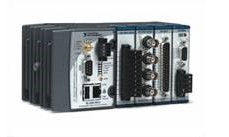At Intergrated Industrial Systems (I2S), we have used programmable logic controllers (PLCs) for years to automate and control our rolling mills. To increase the efficiency and quality of our steel mills, we implement a gamma gauging system to more accurately control the thickness of metal. The gamma gauging system has been a staple of the I2S product family for many years and continues to be a well received product, but many of the features, both hardware and software, have become outdated. To optimize the efficiency of our rolling mills, we needed a custom measurement device with accurate analog I/O along with advanced processing to convert the signal from the sensor to an accurate metal thickness. Unfortunately, the PLCs used to automate the rolling mills did not provide the high-speed analog I/O and processing required. NI CompactRIO PAC hardware proved to be an excellent custom measurement and analysis solution for our application. We were able to easily integrate multiple CompactRIO systems with our existing PLC hardware to quickly improve the quality and efficiency of our rolling mills.
CompactRIO Provides High-Speed Analog I/O and Advanced Processing
The CompactRIO PAC provided the reliability and ruggedness of a PLC for the harsh environment and critical nature of the control system, along with the high-speed analog I/O and signal processing capabilities we required. With NI LabVIEW graphical programming tools and built-in LabVIEW FPGA and LabVIEW Real-Time function blocks, we were able to quickly program the FPGA and real-time processor in CompactRIO. The analog input modules in CompactRIO connect to gamma-based thickness sensors so we can customize the I/O rates and synchronization with the embedded field-programmable gate array (FPGA) of CompactRIO. CompactRIO analog I/O and digital I/O modules connect to gamma-based thickness sensors and the embedded FPGA of CompactRIO allow us to customize the I/O rates and synchronization. The data received from the sensors is then processed in the CompactRIO real-time processor using built-in National Instruments LabVIEW Real-Time floating-point function blocks to convert the data from the sensors to an accurate thickness measurement. LabVIEW real-time performs deterministic, advanced logarithmic processing (as shown below in equations 1 and 2) on the data received from the FPGA to calculate the thickness measurements.
Equation 1: log I = log I0 γ/μ = (γ/μ) log I0
Equation 2: μ = γ log I0 / log I = γ log (I0 – I)
The CompactRIO systems perform all of the I/O and signal processing in the FPGA and real-time processor and transmit a high-accuracy thickness measurement to connected PLCs without slowing down the existing PLC control loop rates. With the performance of CompactRIO, we were able to add this custom measurement and analysis for our gamma-based sensors without compromising our control rate speed.
CompactRIO Connects Easily to Existing PLC Architecture
Each rolling mill contains three networked CompactRIO systems. All three CompactRIO systems are intelligent nodes that communicate with a myriad of controllers using an industrial standard Modbus/TCP, TCP/IP and UDP protocols. Two CompactRIO systems are connected to the gamma-based sensors and are performing the analog input measurements along with the advanced processing to calculate the accurate thickness measurement. The third CompactRIO system takes the thickness measurements from the other two systems and performs an analog output measurement to the PLCs that are controlling the rolling mills. All three CompactRIO systems are connected via an Ethernet connection and are using a UDP Ethernet messaging protocol to transmit the thickness measurement calculations. The processed data is transmitted between networked CompactRIO systems over the Ethernet in less than 20 millisecond intervals. The acquisition, processing and transmission of the CompactRIO measurements all happens fast enough to inject an accurate thickness measurement into the PLC control loop without decreasing control loop speed. The LAN-based CompactRIO systems with a 10/100 Mbps Ethernet port allowed us to easily connect the systems to networked Allen Bradley PLCS and the human machine interface (HMI) system via a standard TCP/IP protocol. All of the instruments within our rolling mills are Ethernet based eliminating the need of have analog signals traveling long distances in an electrical noisy environment. The diagram of the system is shown below in Figure 1.
About a Gamma Gauge
A Gamma Gauge is a device that uses a constant emitting source, in this case Americium. The source is held in the lower portion of a “C”-frame assembly. The top portion of the frame holds a Receiver and Pre-Amplifier. As metal strip travel through the gap separating the Source and Receiver, it absorbs a portion of the radiation, based upon its thickness and density. The amount left over is measured by the receiver and is translated into a strip thickness measurement.
Author Information:
Clark Hummel
I2S
475 Main Street
Yalesville, CT 06492
United States
Tel: (203) 265-5684
clark@i2sworld.com
